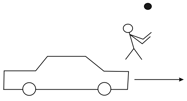Embibe Experts Solutions for Chapter: Projectile Motion, Exercise 2: Exercise 2
Embibe Experts Physics Solutions for Exercise - Embibe Experts Solutions for Chapter: Projectile Motion, Exercise 2: Exercise 2
Attempt the practice questions on Chapter 2: Projectile Motion, Exercise 2: Exercise 2 with hints and solutions to strengthen your understanding. Practice Book for KVPY Aptitude Test - Stream SA Physics solutions are prepared by Experienced Embibe Experts.
Questions from Embibe Experts Solutions for Chapter: Projectile Motion, Exercise 2: Exercise 2 with Hints & Solutions
A boy standing on the foothpath tosses a ball straight up and catches it. The driver of a car passing by moving with uniform velocity sees this.

The trajectory of the ball as seen by the driver will be
According to the quantum theory, a photon of electromagnetic radiation of frequency has energy where is known as Planck's constant. According to the theory of relativity, a particle of mass has equivalent energy , where is speed of light. Thus, a photon can be treated as a particle having effective mass . If a flash of light is sent horizontally in earth's gravitational field, then photons while travelling a horizontal distance would fall through a distance given by -
A firecracker is thrown with velocity of in a direction which makes an angle of with the vertical axis. At some point on its trajectory, the firecracker split into two identical pieces in such a way that one piece falls far from the shooting point. Assuming that all trajectories are contained in the same plane, how far will the other piece fall from the shooting point ? (Take and neglect air resistance)
